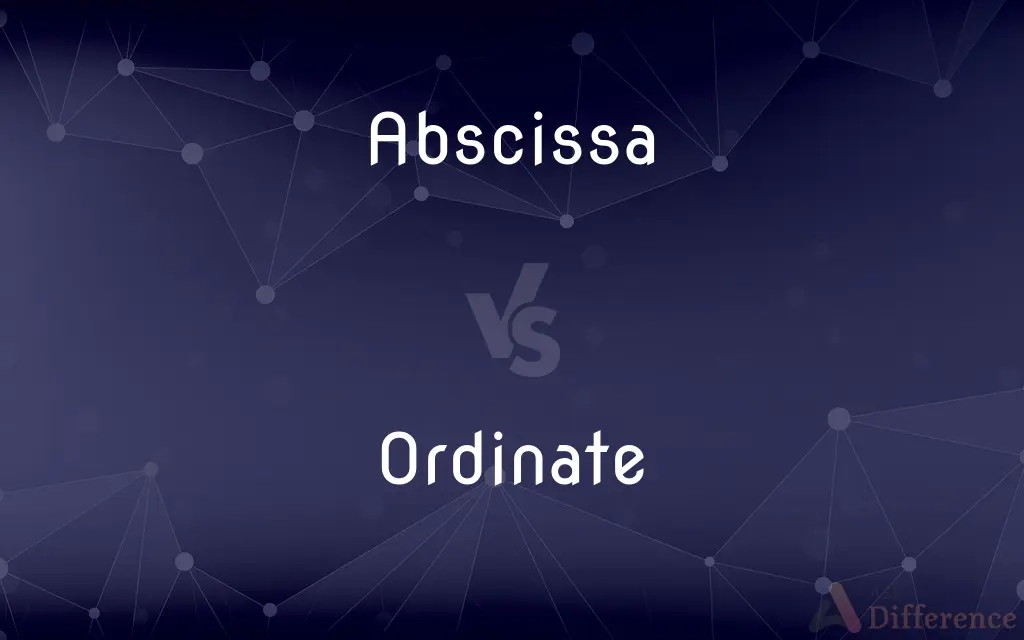Abscissa vs. Ordinate — What's the Difference?
By Fiza Rafique & Urooj Arif — Updated on March 18, 2024
Abscissa refers to the x-coordinate in a Cartesian coordinate system, while ordinate denotes the y-coordinate.

Difference Between Abscissa and Ordinate
Table of Contents
ADVERTISEMENT
Key Differences
The abscissa is the horizontal distance of a point from the vertical axis or y-axis in a two-dimensional graph, essentially representing the x-coordinate. It indicates how far along the horizontal axis a point is positioned. On the other hand, the ordinate is the vertical distance of a point from the horizontal axis or x-axis, representing the y-coordinate and showing how far up or down the point is located on the graph.
In plotting a point on a Cartesian plane, the abscissa (x-coordinate) is always mentioned first, followed by the ordinate (y-coordinate). This order is crucial for accurately locating points on the graph. While the abscissa measures the horizontal aspect of a point's position, the ordinate provides its vertical counterpart, together defining the precise location of a point in the Cartesian coordinate system.
The concept of abscissa is commonly used in various fields such as mathematics, physics, and engineering to describe the horizontal position or dimension in graphs and geometric figures. Similarly, the ordinate is integral to these disciplines for specifying vertical positions and dimensions, with both terms playing key roles in data visualization, geometric analyses, and graphical representations of functions.
In mathematical equations, especially functions, the abscissa often represents the independent variable, with its value determining the value of the dependent variable, or ordinate. This relationship is essential in understanding and interpreting the behavior of functions, as changes in the abscissa (x-value) directly affect the ordinate (y-value) according to the function's rule.
Both abscissa and ordinate are critical in the field of analytic geometry, where they facilitate the exploration of geometric properties and relationships through algebraic processes. By utilizing these coordinates, mathematicians and scientists can solve complex problems involving distance, slope, area, and more, in a two-dimensional space.
ADVERTISEMENT
Comparison Chart
Definition
The x-coordinate in a Cartesian coordinate system, representing horizontal position.
The y-coordinate in a Cartesian coordinate system, representing vertical position.
Axis Association
Associated with the horizontal axis (x-axis).
Associated with the vertical axis (y-axis).
Order in Points
Mentioned first in the ordered pair (x, y).
Mentioned second in the ordered pair (x, y).
Role in Graphs
Indicates horizontal positioning of a point.
Indicates vertical positioning of a point.
Usage
Common in mathematical, physical, and engineering contexts for horizontal dimensions.
Common in the same contexts for vertical dimensions.
Compare with Definitions
Abscissa
The horizontal coordinate in a Cartesian coordinate system, indicating distance from the y-axis.
In the point (3, 2), 3 is the abscissa.
Ordinate
Often corresponds to the dependent variable in functions.
The function's value is determined by the ordinate for a given abscissa.
Abscissa
Often corresponds to the independent variable in functions.
Changes in the abscissa affect the function's output.
Ordinate
The vertical coordinate in a Cartesian coordinate system, indicating distance from the x-axis.
In the point (3, 2), 2 is the ordinate.
Abscissa
Used in mathematical and scientific visualizations for horizontal positioning.
The scientist adjusted the abscissa to align the data points.
Ordinate
Represents the y-value in an ordered pair.
The ordinate of the point shows its height above the x-axis.
Abscissa
Represents the x-value in an ordered pair.
The abscissa of the point shows how far it is along the x-axis.
Ordinate
Essential for assessing vertical relationships and trends in data.
The ordinate values indicated a rising trend.
Abscissa
Crucial for plotting points and understanding horizontal relationships in graphs.
The abscissa helps in analyzing the graph's horizontal spread.
Ordinate
Integral in graphs for vertical measurement and analysis.
Adjusting the ordinate scale changed the graph's appearance.
Abscissa
Symbol xThe coordinate representing the position of a point along a line perpendicular to the y-axis in a plane Cartesian coordinate system.
Ordinate
Arranged in regular rows, as the spots on the wings of an insect.
Abscissa
(geometry) The first of the two terms by which a point is referred to, in a system of fixed rectilinear coordinate (Cartesian coordinate) axes.
The point has 3 as its abscissa and 2 as its ordinate.
Ordinate
Symbol y The plane Cartesian coordinate representing the distance from a specified point to the x-axis, measured parallel to the y-axis.
Abscissa
(geometry) The horizontal line representing an axis of a Cartesian coordinate system, on which the abscissa (sense above) is shown.
Ordinate
(geometry) The second of the two terms by which a point is referred to, in a system of fixed rectilinear coordinate (Cartesian coordinate) axes.
The point has 3 as its abscissa and 2 as its ordinate.
Abscissa
One of the elements of reference by which a point, as of a curve, is referred to a system of fixed rectilineal coördinate axes.
Ordinate
(geometry) The vertical line representing an axis of a Cartesian coordinate system, on which the ordinate (sense above) is shown.
Abscissa
The value of a coordinate on the horizontal axis
Ordinate
To ordain a priest, or consecrate a bishop
Ordinate
(transitive) to align a series of objects
Ordinate
Arranged regularly in rows; orderly; disposed or arranged in an orderly or regular fashion.
Ordinate
Well-ordered; orderly; regular; methodical.
Ordinate
The distance of any point in a curve or a straight line, measured on a line called the axis of ordinates or on a line parallel to it, from another line called the axis of abscissas, on which the corresponding abscissa of the point is measured.
Ordinate
To appoint, to regulate; to harmonize.
Ordinate
The value of a coordinate on the vertical axis
Ordinate
Appoint to a clerical posts;
He was ordained in the Church
Ordinate
Bring (components or parts) into proper or desirable coordination correlation;
Align the wheels of my car
Ordinate similar parts
Common Curiosities
What is an abscissa?
An abscissa is the horizontal coordinate (x-coordinate) in a Cartesian coordinate system, indicating a point's distance from the vertical axis (y-axis).
How are abscissa and ordinate used together?
Together, the abscissa (x-coordinate) and ordinate (y-coordinate) define a point's exact position on a Cartesian plane, with the abscissa specifying the horizontal and the ordinate the vertical location.
Can the abscissa and ordinate be negative?
Yes, both abscissa and ordinate can be negative, indicating that the point lies to the left of the y-axis or below the x-axis, respectively, in a Cartesian coordinate system.
What does ordinate mean?
An ordinate is the vertical coordinate (y-coordinate) in a Cartesian coordinate system, showing a point's distance from the horizontal axis (x-axis).
Do abscissa and ordinate apply to 3D graphs as well?
In 3D Cartesian coordinate systems, the concepts of abscissa (x-coordinate) and ordinate (y-coordinate) still apply, with the addition of a third coordinate, the applicate (z-coordinate), for the third dimension.
How do changes in the abscissa affect a graph?
Changes in the abscissa (x-value) can alter the position of points along the horizontal axis, potentially affecting the graph's shape and the interpretation of the data or function it represents.
What is the significance of the ordinate in mathematical functions?
The ordinate often represents the output or dependent variable of a function, with its value determined by the input or independent variable (abscissa), highlighting the function's behavior.
Are abscissa and ordinate used in non-Cartesian coordinate systems?
While primarily associated with Cartesian systems, the concepts of horizontal and vertical positioning (akin to abscissa and ordinate) can be adapted to other systems, like polar coordinates, with different terminologies and interpretations.
Why are abscissa and ordinate important in graphs?
They are crucial for plotting points, understanding spatial relationships, and analyzing trends within the Cartesian coordinate system, aiding in the visualization and interpretation of data.
Can we find the distance between two points using abscissa and ordinate?
Yes, by calculating the differences in abscissas (Δx) and ordinates (Δy) between two points, one can use the Pythagorean theorem to find the distance between them in a Cartesian plane.
Share Your Discovery

Previous Comparison
Bully vs. Tyrant
Next Comparison
Fluent vs. ProficientAuthor Spotlight
Written by
Fiza RafiqueFiza Rafique is a skilled content writer at AskDifference.com, where she meticulously refines and enhances written pieces. Drawing from her vast editorial expertise, Fiza ensures clarity, accuracy, and precision in every article. Passionate about language, she continually seeks to elevate the quality of content for readers worldwide.
Co-written by
Urooj ArifUrooj is a skilled content writer at Ask Difference, known for her exceptional ability to simplify complex topics into engaging and informative content. With a passion for research and a flair for clear, concise writing, she consistently delivers articles that resonate with our diverse audience.
















































